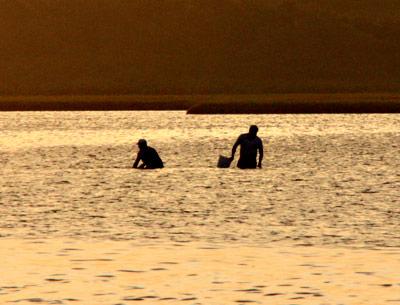Some Shellfishing Halted

The State Department of Environmental Conservation has reclassified two East Hampton Town waterways, where the harvesting of shellfish from specific areas will be prohibited on a year-round or seasonal basis.
On Friday, the agency announced emergency regulations that changed the designation of underwater shellfish lands for 3,690 acres of Long Island waters. The move, according to the D.E.C., resulted from its analyses demonstrating increased levels of fecal coliform bacteria and the potential for shellfish harvested from the areas in question to cause illness if consumed.
In East Hampton, approximately 15 acres of Hand’s Creek was reclassified from seasonally uncertified, or closed to the harvesting of shellfish, to uncertified year round. The reclassified area includes all waterways, including tributaries, lying west of a line extending northerly from an orange marker located on the southern side of the entrance channel to the opposite shoreline. Additionally, from May 1 through Nov. 30, the area within a 500-foot radius in all directions of the entrance to Hand’s Creek is now uncertified.
In Accabonac Harbor, where the northernmost portion is already closed to the harvesting of shellfish throughout the year, approximately 14 acres were reclassified from certified, or open, to seasonally uncertified. From May 1 through Nov. 30, the area lying west of a line extending southwesterly from the westernmost point of land of the property at 128 Gerard Drive, Springs, to an orange marker at the opposite shoreline, and south of the uncertified area (the northernmost portion), will also be closed to shellfishing.
Some 15 acres of Cold Spring Pond in Southampton were also designated as seasonally uncertified. The D.E.C. designated 10 acres in Shinnecock Bay uncertified, as well as 3 acres in Gull Pond, in Southold.
The reclassifications were made “because they did not meet the fecal coliform standards [in D.E.C. regulations] for certified shellfish lands,” Bill Fonda, an agency spokesman, wrote in an e-mail. The presence of fecal coliforms in the marine environment, he wrote, “indicates the likely presence of fecal material, including pathogenic bacteria and viruses, in the water that increases the potential for consumers to become ill if they eat shellfish from areas which have elevated levels of fecal coliforms.”
In March, the East Hampton Town Trustees, who manage the waterways and bottomlands on behalf of the public, announced a program to monitor the waters under their jurisdiction in cooperation with Christopher Gobler of Stony Brook University. The D.E.C.’s reclassifications “do not necessarily reflect the water quality of these systems as a whole,” Stephanie Forsberg, a trustee who delivers regular aquaculture reports to her colleagues, wrote in an e-mail. Ms. Forsberg earned a doctoral degree in marine biology from Stony Brook last year, working in Mr. Gobler’s laboratory as part of her studies.
Overall water quality in trustee waters, she wrote, “is a bigger-picture question,” one she said the trustees were sure to consider at their next meeting, on Tuesday.
Diane McNally, the trustees’ clerk, cautioned against drawing definitive conclusions from the D.E.C.’s action, which she said is based on three years’ worth of data. In the course of those three years, she said, Lisa Tettelbach, of the D.E.C.’s Bureau of Marine Resources, “needed to get her colleagues to the water body a certain number of times per year, after a certain amount of rain. That has been difficult for her, she doesn’t have the staff.”
The D.E.C., Ms. McNally said, “is making projections based on data they have, but it might not always be the best data. They have to make a judgment call based on health and safety, on the probability that there could be an issue.”
In August, the trustees hired Michael Bye as a pumpout boat operator. Last month, Ms. McNally announced to her colleagues that Mr. Bye, a bayman, had received training in water-quality sampling from the D.E.C. and would be able to augment the agency’s testing with regular reports on water quality in shellfish beds. “If we can get those samples to them, we might get a more accurate picture,” she said.
